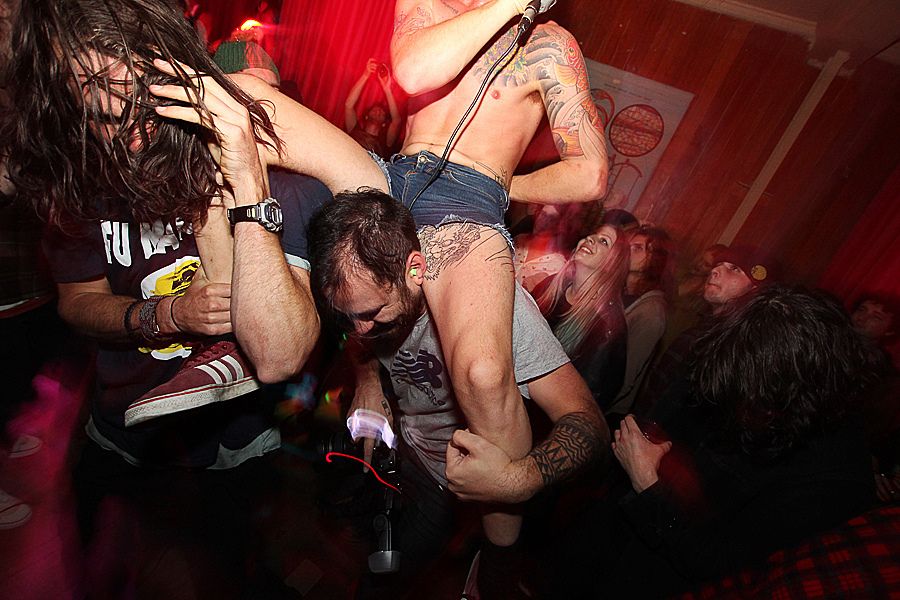Internet Histories | 27 January
The death of the venue and longform journalism in 2014.
This fortnight:
The death of the venue | Longform journalism in 2014
Joe
“Dedicated to the Rhumba Bar, Liberty Stage, Windsor Castle, Gladstone, Cook, XS Café, Squeeze, Station Hotel, Last Resort, Mainstreet, countless church halls and the rest of those long-lost things they call venues” – Liner Notes to It’s Bigger Than Both Of Us: NZ Singles 1979-82 (released 1988)
Mighty Mighty is closing! San Fran Bathhouse in a twilight of semi-permanent overhaul! It’s Wellington’s turn to panic and wax nostalgic about the recent past (it’s always one New Zealand city of scale if not the other) but anyone who wants to write an obituary for a venue space/their entire scene just received a life lesson in how not to do this in the near-messianic treatment of New York City’s 285 Kent. It’s the little DIY venue that could/did for a grand total of two-and-a-half years. That’s probably an okay run anywhere for an all-ages space without any institutional funding, and to have set something in that in motion is thankless but remarkable.
The wake has been unbearable, though. At the death, 285 Kent has become a sort of lazy talisman of cool for publications and their sponsors. In the hands of Pitchfork’s Devon Maloney and The New Yorker’s David Shapiro, it’s like someone else did the legwork for the self-aggrandizing tastemakers.
Shapiro relates how inclusive and unorthodox the venue was with… well… celebrities. One time A$AP Rocky came there after a show! And Odd Future! And Sky Ferreira! Noted Foo Fighters openers Fucked Up even showed up to play “Blitzkrieg Bop”, which is a knowing tribute to… playing “Blitzkrieg Bop”, I guess.
Pitchfork’s piece looks like a Converse ad at the top (I’m not even entirely sure it isn’t) and uses the space’s narrative to thread together the acts it’s already hitched its wagon to, a sort of cult of personality for your constructed identity as a Pitchfork reader circa 2012-13. Both publications take a time out from telling us about quite famous people who went there to wag a stern finger at the rising rents and development that squeezed the team behind 285 Kent out. No one hates gentrification like the other gentrifiers.
Noisey comes and goes, but it’s a valuable corrective in this instance for anywhere – everywhere – where a venue starts, flourishes and dies:
285 Kent is precisely the sort of place that pops up in a given city and lasts until the cops shut it down one time too many or the promoters lose interest. Here today, gone tomorrow, D.I.Y. venues generally don’t stick around forever…There’s no denying that 285 Kent means something to a select community of people—musicians and concertgoers alike. Though on the surface it doesn’t appear all that special, those preparing to mourn it during these farewell shows and afterwards made memories, connections, friends, enemies, and lovers there. Other venues will pick up the slack, and the bookers appear intent on bringing future shows to other space. Still, let’s all try and keep the hyperbole to a minimum.
There’s nothing wrong with saying goodbye to a place that means something. But the loss of one D.I.Y. space is not the death knell of a sprawling movement that has survived decades of aggressive law enforcement, maddening city bureaucracy, and scene politics. As adaptable and perserverent as a cockroach, punk has no reason or incentive to lie down and die.
The pervasive mythology of spaces, particularly in rock press – an assumption that a community has to inhabit or associate under one consistently branded umbrella – isn’t about those communities at all. It’s just a lot easier to sell. And that conflagration of people and blackouts and amp freakouts and messy fucks and the networks beyond them isn’t easily compacted into a sealed end-product of cool, and nor should it be.
There’s always value in protecting the opportunity for these spaces to arrive. It’s true when you’re in NYC. It’s also absolutely true here in Auckland – and in Wellington, and in the reconstructed Christchurch – but doing that is about clear-eyed vigilance, not a cosy and readily-compromised nostalgia for what’s virtually the present. Actually, it turns out it’s bigger than all of us.
Adam
On January 6, freelance game writer / wunderkind Cara Ellison started a Patreon. She's one of a number of game writers who are turning to the online patronage site to fund the unfundable - editorials, reviews of forgotten mediocrities, indie game curation and the like. Ellison offered up 'embedded games journalism' -
I will give up my nice comfortable cottage rental in Brighton and use the money to journey to the most exciting auteurs of our medium, stay with them, explore their outlook, ask how their environment affects their design. This is a thing that game journalism usually cannot afford to pay the travel for or the time for and so we don't get this in-depth content. Or perhaps it is that no one is interested in this. But I am.
On January 22, Ellison published the first journalism, EMBED WITH...LONDON. It's about her week-long stay with George Buckenham and Alice O'Connor, two London indie developers. It's about their cold flat, their developer friends, their 'Wild Rumpus' game parties, their friendly cat, their games, their reasons, their enthusiasm. (Buckenham's explanation of how he came into video games is a pretty incredible distillation of what makes them a medium deserving of nuanced criticism.)
It's also about London, its cold, its darkness, its weary buildings, its communities plugging away against all that. It's personal, a person writing about their friends and the place she hates. It's muddy and weird and immersive. It aches with admiration and a need to move forward. It almost certainly wouldn't be commissioned, let alone published, by any conventional gaming outlet.
On January 26, I found myself agreeing with Jonathan Mahler's NYT column on the cult of longform in the wake of Grantland's ugly article about the putter and the self-absorbed reporter. I nodded at the idea of a writer not being a 'participant', of a writer's place being that of an observer who offers critical asides about their subjects and their reporting.
Ellison's piece is 'longform' in that it's magazine-length narrative-driven reporting. But it's unwieldy reporting, abstracted in a way Mahler would probably reject. The narrative is experiential, the reporting spliced in with Ellison's own observations about her history and her history with London. The writer's as much a subject as the people she's designated subjects. Does Mahler's ideal of longform allow for that? Does Mahler's plea for empathy require reporters remain at armslength?
Because maybe it shouldn't.


